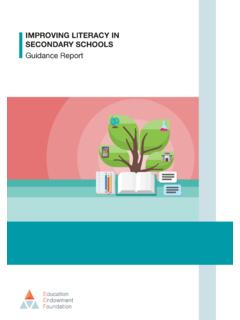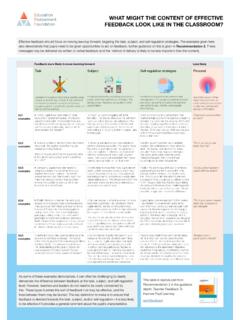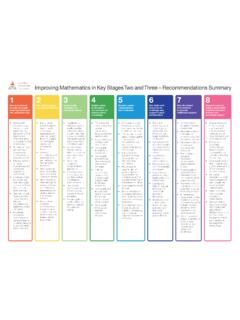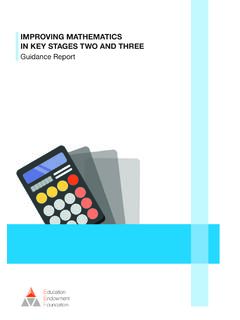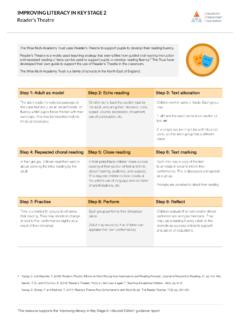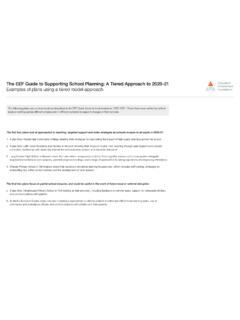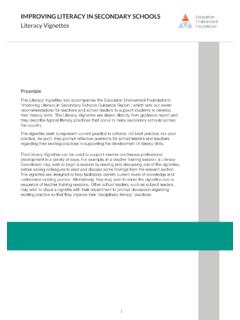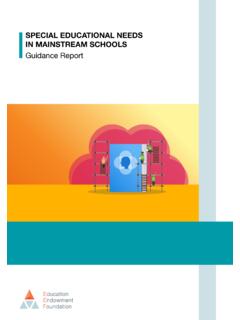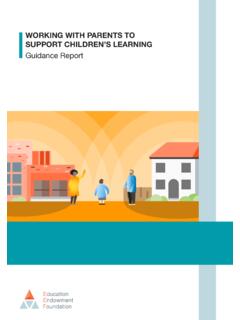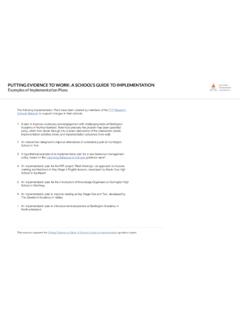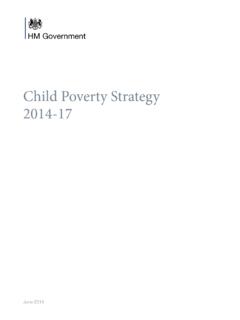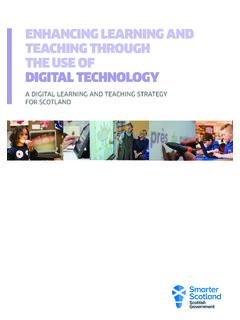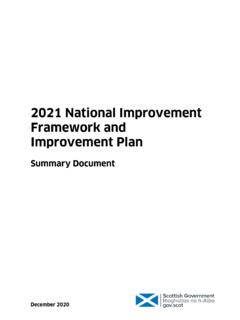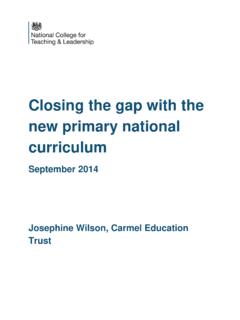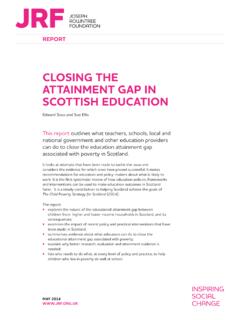Transcription of The EEF Guide to the Pupil Premium—Autumn 2021
1 The EEF Guide to the Pupil Premium Autumn 2021. About the Education Endowment Foundation The Education Endowment Foundation (EEF) is an independent charity supporting teachers and school leaders to use evidence of what works and what doesn't to improve educational outcomes, especially for disadvantaged children and young people. Education Endowment Foundation Contents Foreword 2. The tiered approach to school improvement 3. The four-step approach to strategy 4. Pupil premium strategy content: . Step 1 Diagnosing your pupils' needs 6. Step 2 Use strong evidence to support your strategy 8. Step 3 Implement your strategy 10.
2 Step 4 Monitor and evaluate your strategy 12. Pupil premium myths 14. Accessing and interpreting evidence 16.. The EEF Guide to the Pupil Premium Autumn 2021 1. Foreword Covid has potentially For the first time, the updated Pupil premium reversed a decade of reporting template requires schools to progress in closing the demonstrate that they have considered attainment gap. The evidence when developing their strategy. We evidence is clear that hope that the new section in this Guide on using disadvantaged students and interpreting evidence' will support school have fallen further behind leaders to engage critically with evidence as during the pandemic.
3 They develop their strategy for the 2021 22. And we know that these academic year and beyond. students will also face the biggest challenges in Supporting education recovery for those educational recovery. children most in need will not be an easy task. And yet, our hope is that this guidance will help In this context, it is more important than ever to support an excellent, evidence-informed to focus our efforts on what evidence tells us is education system in England that creates great most likely to be effective for pupils from lower opportunities for all children and young people, socio-economic backgrounds. regardless of their family background.
4 A decade of research into educational disadvantage has shown there are no silver bullets', but engaging with evidence offers schools a valuable tool for understanding which practices and programmes are most likely to deliver the greatest impact. This Guide is designed as a practical starting point to support school leaders to develop, implement and monitor an evidence-informed approach to their Pupil premium strategy. The Guide suggests a four-step cycle for school Professor Becky Francis leaders to follow when developing and sustaining Chief Executive their strategy. Education Endowment Foundation 2 Education Endowment Foundation The tiered approach to school improvement Considering a tiered approach to Pupil Premium 2.
5 Targeted academic support spending can help schools balance approaches to improving teaching, targeted academic Evidence consistently shows the positive support, and wider strategies. impact that targeted academic support can have, including on those who are not making The tiered approach aligns with the DfE strategy good progress, or those who have been template, so school leaders can be confident that disproportionately impacted by the effects of their school improvement approach meets the the pandemic. Considering how classroom needs of their pupils and fulfils the expectations teachers and teaching assistants can provide of the Pupil premium strategy document.
6 Targeted academic support, such as linking structured small group interventions to classroom teaching and the curriculum, is likely 1 2 to be an essential ingredient of an effective Pupil premium strategy. 3. Wider strategies Wider strategies relate to the most significant non-academic challenges to success in school, including attendance, behaviour, and social and emotional support, which also may negatively impact upon academic attainment . Given the 3. impact of the pandemic, issues such as securing high levels of attendance may be more prominent for schools as they develop their strategy. While many challenges may be common between schools, it is also likely that the specific features 1.
7 High quality teaching of the community each school serves will affect spending in this category. Spending on developing high quality teaching may include investment in professional Many approaches within the tiered model will development, training and support for early career overlap categories, and the balance between teachers, along with recruitment and retention. categories will vary from year to year as Ensuring an effective teacher is in front of every schools' priorities change. class, and that every teacher is supported to keep improving, is the key ingredient of a successful Schools should always combine evidence with school and should rightly be a top priority for Pupil professional judgement about how transferable premium spending.
8 Approaches are to their own setting. The EEF Guide to the Pupil Premium Autumn 2021 3. The four-step approach to strategy School leaders may wish to consider the following four-step approach when developing and sustaining their strategy: 1 Diagnose your pupils' needs 2 Use strong evidence to support your strategy 3 Implement your strategy 4 Monitor and evaluate your strategy 4 Education Endowment Foundation The development of an effective Pupil and publish an updated strategy statement premium strategy should be cyclical and be every academic year before 31 December. considered an integral part of existing school development planning.
9 Setting longer-term objectives will give you the time and space to diagnose the challenges The DfE recommend a longer-term three year facing your disadvantages pupils accurately and approach to planning, but require that if you implement key elements of your strategy plan, use a multi-year approach, you still must review such as spending, recruitment, teaching practice and staff development. Use strong Diagnose your evidence to pupils' needs support your strategy Monitor and Implement evaluate your your strategy strategy The EEF Guide to the Pupil Premium Autumn 2021 5. 1 Diagnosing your pupils' needs Gaining a thorough knowledge of your developing their strategy.
10 These can be disadvantaged pupils' levels of attainment is identified using a wide range of internal data and the first step in developing an effective Pupil information, including: premium strategy. Attendance data and levels of Once you have gauged the performance of persistent absence;. your disadvantaged pupils against national benchmarks, for pupils whose attainment is Teacher feedback on pupils' levels of below age related expectations, you should engagement and participation;. examine what could be hindering their attainment . Behaviour incidences and exclusions data;. This will involve diagnostic assessment of academic challenges, but also take account of Information on wellbeing, mental health wider challenges, such as attendance.
